Blood sausage
This article needs additional citations for verification. (December 2007) |
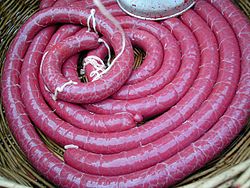 Black Pudding (Boudin noir), before cooking | |
| Alternative names | Blood pudding Morcilla Mi xue gao(米血糕) Boudin noir Lancashire pudding Marag Dubh (Scots Gaelic) |
|---|---|
| Serving temperature | Hot or cold |
| Main ingredients | Blood |
| Nutritional value per 100 g (3.5 oz) | |||||||||||||
|---|---|---|---|---|---|---|---|---|---|---|---|---|---|
| Energy | 1,586 kJ (379 kcal) | ||||||||||||
1 g | |||||||||||||
| Sugars | 1 g | ||||||||||||
35 g | |||||||||||||
15 g | |||||||||||||
| |||||||||||||
| †Percentages estimated using US recommendations for adults,[1] except for potassium, which is estimated based on expert recommendation from the National Academies.[2] | |||||||||||||
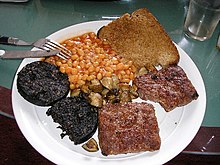
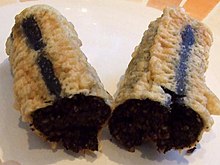
Black pudding, blood pudding or blood sausage is a type of sausage made by cooking blood or dried blood with a filler until it is thick enough to congeal when cooled. The dish exists in various cultures from Asia to America. Pig, cattle, sheep, duck and goat blood can be used depending on different countries.
In Europe, typical fillers include meat, fat, suet, bread, sweet potato, onion, chestnuts, barley, and oatmeal while in Spain and Asia, potato is often replaced by rice.
Regional variants
The Americas

As German Americans are one of the largest ancestral groups in the United States, foods like blood sausage (sometimes still called Blutwurst) are still eaten in the country, although often by older generations. Among other English-speaking North Americans, the consumption of British-style black pudding and similar dishes is largely confined to recent immigrants from Great Britain, Ireland, Australia, and so forth. This Old World tradition also continues with French Canadians and Cajuns[Acadians]. Blood sausages are very difficult to find in American supermarkets, and are often made at home, especially by the older generations. In Wisconsin, Brussels and Sturgeon Bay are both home to local grocers who produce blood sausage, due to their large Belgian American populations. Supermarkets throughout Maine also carry locally produced blood pudding due to the state's large French Canadian population. In southeastern Michigan, Polish-style kiszka can be found in supermarkets throughout the year, but more so during Easter. This is largely due to the sizable Polish ancestry throughout the region.
An Italian-American version of black pudding in the San Francisco Bay area is called biroldo and has pine nuts, raisins, spices, pig snouts and is made using either pig’s or cow's blood.
Cajun boudin is a fresh sausage made with green onions, pork, livers (usually chicken), and rice. Pig's blood was sometimes added to produce boudin rouge, but this tradition became increasingly rare after the mid-twentieth century due to the decline of the boucherie (traditional communal butchering) and government health regulations. As a result, Cajun boudin is now usually made without blood.
In many areas of Latin America, morcilla is served. Morcilla is sometimes made with a filler of rice and/or onions, and seasoned with paprika and other spices. In Puerto Rico, it is made spicy-hot and served fried. In some countries of South America, morcilla is a traditional component of the asado, a regional mixed grill or barbecue meal. In Venezuela, morcilla is often served with parrilla (barbecue). Morcilla is also eaten inside a sandwich called "morcipán," especially in Argentina and other Río de la Plata countries; in Uruguay, although not in Argentina, a sweet and sour version including raisins and pine nuts is popular, some vendors even adding chocolate, caramelized orange peels, peanuts, and other dried fruits. Uruguayans usually are fond of sweet or salty morcilla, and most restaurants and supermarkets carry both versions. In Chile, it is called prieta. In Ecuador it is called salchicha. In Panama and Colombia, it is called morcilla, rellena or tubería negra, and is usually filled with rice. In Brazil, as in Portugal, morcela and chouriço de sangue are eaten. In Nicaragua, it is called "moronga".
In Guyana, the main ingredient in black pudding is cooked rice seasoned with herbs, such as thyme and basil. The rice is mixed with cow's blood, stuffed into cow's or pig's intestine, and boiled until firm. It is served as an appetizer or snack, often with any type of hot sauce, mild to hot, depending on preference and regional area.
In Suriname, black pudding is known by the Dutch name bloedworst, and white pudding by the also Dutch name vleesworst.
The Caribbean
In Antigua, rice pudding is a local delicacy and it is prepared the same way as black pudding. In the French Antilles boudin antillais is very popular, this being the French boudin noir with local Caribbean chili and other spices.
In Trinidad & Tobago, a version of black pudding heavily seasoned with local peppers is prepared from pig's blood. It is sold by local producers as a popular accompaniment to rolls of crusty hops bread.
Asia
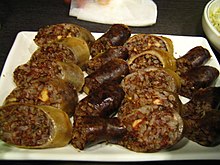


Across Asia, various peoples create foods from congealed animal blood. Most of these foods do not have casing and might be considered a version of sliced sausage. In the Chinese cultures, whole coagulated blood is fried or steamed as a snack or cooked in a hot pot. In Mainland China, "blood tofu" (Chinese: 血豆腐; pinyin: xiě dòufǔ), or "red tofu" (Chinese: 红豆腐; pinyin: hóng dòufǔ), is most often made with pig's or duck's blood, although chicken's or cow's blood may also be used. Like the above dishes, this has no casing but is simply cut into rectangular pieces and cooked. In the Northeast China, the "blood sausage" is a traditional food which is cooked with sheep or goat blood. In resource-poor Tibet, congealed yak's blood is a traditional food.[3][4] In Hong Kong, the dish is only made with pig's blood and simply called "pig red" (Chinese: 豬紅). In Taiwan, pig's blood cake (Chinese: 豬血糕; pinyin: zhū xiě gāo), made of pork blood and sticky rice is served on a popsicle stick is a very popular snack at local night marketsn Taiwan.
In Tibetan cuisine, sausages or "gyurma" refer to blood sausages and are made with yak or sheep's blood which may or may not inlcude either rice or roasted barley flour as filler. The sausage uses natural casing employing the use of yak or sheep's intestine.
A similar dish from the Philippines, dinuguan (from the word dugo meaning "blood") (pork-blood stew) is a stew consisting of diced beef or pork meat and organs with pig or cow blood simmered in a rich, spicy gravy of pig blood, garlic, chili and vinegar. Because the stew is thick and dark, the euphemism "chocolate meat" was coined. Dinuguan is often served with white rice or a Philippine rice cake called puto. A Philippine delicacy is known by its colloquial name, "betamax," which is—like the Chinese blood tofu—congealed chicken blood cut into cubes and then either fried or barbecued.
This dish, dinuguan, is also known in Java as saren, which is made with chicken's or pig's blood.
The majority of Korea's sundae (순대) can be categorized as blood sausage. The most common type of soondae is made of potato noodle (dangmyeon), barley, and pig's blood but some variants contain sesame leaves, green onion, fermented soy paste (doenjang), sweet rice, kimchi, bean sprouts, in addition to the common ingredients.
Vietnamese 'dồi tiết' (Northern) or 'dồi huyết' (Southern) is blood sausage, boiled or fried, made with pork blood, pork fat, basil.
In Thai cuisine sai krok lueat (Thai: ไส้กรอกเลือด) is a blood sausage (Thai: sai krok = sausage, Thai: lueat = blood), often served sliced and accompanied by a spicy dipping sauce. "Blood tofu" is simply called lueat (Thai: เลือด, blood) in Thailand. This can be used in many Thai dishes such as in noodle soups, Thai curries, or as an addition to certain rice dishes such as Khao man kai.
Europe
While the phrase "blood sausage" in English is understood in Britain, it is never used unless in the context of depicting foreign usage (e.g., in the story "The Name-Day" by Saki), or when describing similar blood-based sausages elsewhere in the world.
Black pudding in the United Kingdom is generally made from pork blood and a relatively high proportion of oatmeal; in the past it was occasionally flavoured with pennyroyal, differing from continental European versions in its relatively limited range of ingredients and reliance on oatmeal instead of onions to absorb the blood.[5] It can be eaten uncooked, but is often grilled, fried or boiled in its skin.
In the UK, black pudding is considered a delicacy in the Black Country, where it can trace its origins back hundreds of years.It is also but to a lesser extent, associated with Lancashire and particularly with the town of Bury, where it is usually boiled and served with malt vinegar out of paper wrapping.[6] In the remainder of the country, and especially in the south, it is usually served sliced and fried or grilled as part of a traditional full breakfast; it is also served this way in Ireland, New Zealand, and the Canadian provinces of Nova Scotia and Newfoundland and Labrador. The further addition of the similar white pudding is an important feature of the traditional Northumbrian, Scottish, Irish and Newfoundland breakfast.
Towns other than Dudley in the West Midlands noted for their black pudding include BuryClonakilty, County Cork in Ireland's south west, and Stornoway, Isle of Lewis off the west coast of Scotland.
Black and white pudding, as well as a third variant red pudding is served battered at chip shops in Scotland and England as an alternative to fish and chips.

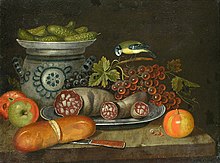
The most common variant of German Blutwurst is made from pork rind, pork blood and regionally different fillers such as barley. Though already cooked and "ready to eat" it is sometimes served warm, similar to the usage in France. In the Rhineland, where it is also traditionally made from horse meat, fried Blutwurst is a part of various dishes. In particular in Cologne, the traditional Himmel und Erde (Heaven and Earth) combines apple sauce, mashed potatoes and Blutwurst served hot on one plate. In Berlin, hot Blutwurst mixed together with liverwurst and potatoes is called "Tote Oma" ("Dead Grandma").
Other German variants are Zungenwurst, which is Blutwurst mixed with pieces of pickled ox's tongue and Beutelwurst which is pressed in a linen or paper bag (Beutel).
A variety of Blutwurst, the Rotwurst from Thuringia (Thüringer Rotwurst) has geographical indication protection under EU law, with PGI status. Kartoffelwurst (potato sausage) is a post-World War II variety popular in the Palatinate, a fat-reduced version of Blutwurst using potato cubes instead of bacon.
In France, boudin is traditionally prepared in charcuteries, shops that prepare mainly pork products (and sometimes duck and game), but also sell smoked and dried sausages, pâtés, and terrines, along with prepared salads. It may also be called boudin noir, is often made with cream and has apples or onions as a filler. It is generally served with either cooked apples, mashed potatoes or both, and is appreciated by combining either the apples or mashed potatoes with each bite of boudin, which has been gently heated and browned in butter. In France also, there are many regional different Boudins Noirs' such as the large 'Boudin du Béarn with pork meat pieces eaten usually cold. The French Confrérie des Chevaliers du Goûte Boudin (Brotherhood of the Knights of Blood Sausage) in Mortagne-au-Perche in southern Normandy holds an annual contest of international blood sausage specialities.
In Belgium and the Netherlands, bloedworst or beuling is sold either in 4-inch-diameter (100 mm) slices, or individual sausages the size of a banana. It is generally pan fried; sometimes apples are cooked alongside or on top of the pieces. It is also eaten with apple sauce, brown sugar or syrup. As a cold cut, thin slices are eaten as a sandwich topping.
In Italy, and more precisely in Tuscany, buristo is a sausage made in the stomach of pork with pork blood and fat. It is not reheated and is often spread on bread. It is found only in the south of Tuscany in winter months and even there it can be difficult to come by.
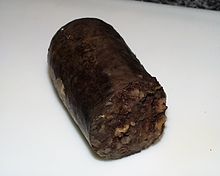

Spanish morcilla has many variants. The most well-known and widespread is morcilla de Burgos which contains mainly pork blood and fat, rice, onions, and salt. In Albacete and La Mancha, the morcilla is filled with onions instead of rice, which completely changes the texture. It is claimed that this is the original morcilla, and rice was introduced in them to reduce costs (rice expands while onion reduces thus needing more raw material). Other varieties introduce breadcrumbs, pine nuts, almonds and vary the proportions of the other ingredients or flavorings, producing even a sweet morcilla from Galicia in the northwestern region, which is fried and served most commonly as a dessert.
In Portuguese cuisine, there are also many varieties of black pudding, ranging from some similar to the Spanish morcilla, known in Portuguese as morcela, to some done only with blood (known as chouriço de sangue).
In Iceland, blóðmör is one of two types of slátur. It is made from lamb's blood and suet, rye flour and oats, traditionally stuffed into pouches sewn from the lamb's stomach. It is usually boiled in its skin, eaten hot or cold, sometimes sliced and fried. After cooking, it is often preserved in fermented whey and acquires a distinct sour taste.
Blodpudding is popular in Sweden, and there are variants such as blodkorv (blood sausage), blodplättar (blood pancakes) and blodpalt. There is also a soup made from blood, called svartsoppa (black soup). One traditional way of serving blood pudding in Sweden is with bacon, cabbage, and lingonberry jam.
Alongside the mustamakkara (black sausage) in Finland, a dish similar to black pudding is made by making batter out of pig's blood and baking it like pancakes. Traditionally, rye flour or oatmeal is used and minced onion is added to the mix. This dish is called veriohukainen (blood pancake). It is similar to the Swedish dish blodplättar above, and is alternatively called veriletut (using a Finland-Swedish term for pancakes instead of a native Finnish one). A dish similar to Swedish svartsoppa is a traditional northern Finnish soup made of rössypottu (blood pudding).
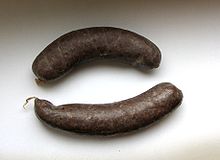
In Estonia, verivorst (blood sausage) is very similar to Finnish mustamakkara. It is sold and eaten mostly in winter, being a traditional Christmas food. At that time there is a large variety of verivorst in stores, ranging in different shapes and sizes. Verivorst is usually cooked in an oven, but sometimes also fried in a pan. Like in Finland, verivorst is often eaten together with lingonberry jam, but occasionally also with butter or sour cream. Another similar dish is called verikäkk (blood dumpling). Its popularity has decreased during the past decades (possibly because of its less appealing commercial appearance) and has mostly been substituted by verivorst.
Throughout Eastern Europe, blood sausage, known as kishka (meaning “intestine”), is made with pig's blood and buckwheat kasha. It is also known in Russia as krovyanka (кровянка), or krovyanaya kolbasa (кровяная колбаса, literally "blood sausage"), and include buckwheat as a main filler, instead of oats or oatmeal. In Ukraine it's called krov'yanka (кров'янка) or kryvava kyshka (кривава кишка), kiszka or kaszanka in Poland, and krupniok in Silesia. Polish salceson ("black" and "Brunszwicki") are a type of head cheese that contains blood. In Hungary, véres hurka is made with rice, pig's blood and pork. In Bulgaria, karvavitsa (кървавица) is usually prepared with pig's blood, fat and a variety of mountain herbs and spices and eaten warm during the winter. A similar blood sausage, called krvavica, is also eaten in Bosnia, Croatia, Serbia, and Slovenia.
In Romania, the traditional sângerete (Romania) (from sânge, "blood" in Romanian) is made from shoulder butt pork meat, pork blood and a filler such as pre-boiled rice seasoned with pepper, garlic and basil. It has many regional variants, but the most common are the sângerete from Transylvania.
Similarly, in Czech cuisine, jelito is made from second-rate pork, pig's blood and peeled barley; the stuffing served by itself, unformed, is called prejt.
Additional varieties
Other varieties of blood sausage include blodpølse (Norway and Denmark), tongeworst (with added pigs tongues) (Netherlands), boudin rouge (Creole and Cajun), rellena or moronga (Mexico), krvavica (Balkans), krovianka (Russia and Ukraine), sanganel (Friuli), and ragati (Nepal).
See also
- Full breakfast
- Breakfast roll
- Sliced sausage
- White pudding
- Red pudding
- Blood soup
- Commonwealth Black Pudding Throwing Championships
- Ecky thump
References
- ^ United States Food and Drug Administration (2024). "Daily Value on the Nutrition and Supplement Facts Labels". FDA. Archived from the original on 2024-03-27. Retrieved 2024-03-28.
- ^ National Academies of Sciences, Engineering, and Medicine; Health and Medicine Division; Food and Nutrition Board; Committee to Review the Dietary Reference Intakes for Sodium and Potassium (2019). Oria, Maria; Harrison, Meghan; Stallings, Virginia A. (eds.). Dietary Reference Intakes for Sodium and Potassium. The National Academies Collection: Reports funded by National Institutes of Health. Washington, DC: National Academies Press (US). ISBN 978-0-309-48834-1. PMID 30844154. Archived from the original on 2024-05-09. Retrieved 2024-06-21.
- ^ Ma Jian, Stick Out Your Tongue Chatto and Windus London, 2006.
- ^ Uses of yak blood in Tibet. Retrieved on 9 May 2009.
- ^ Jaine, T. and Davidson, A. The Oxford companion to food, OUP, 2006, p.104
- ^ Lancashire and Cheshire Regional Dishes, accessed 30-04-10
External links
- Black pudding recipe from uktv food
